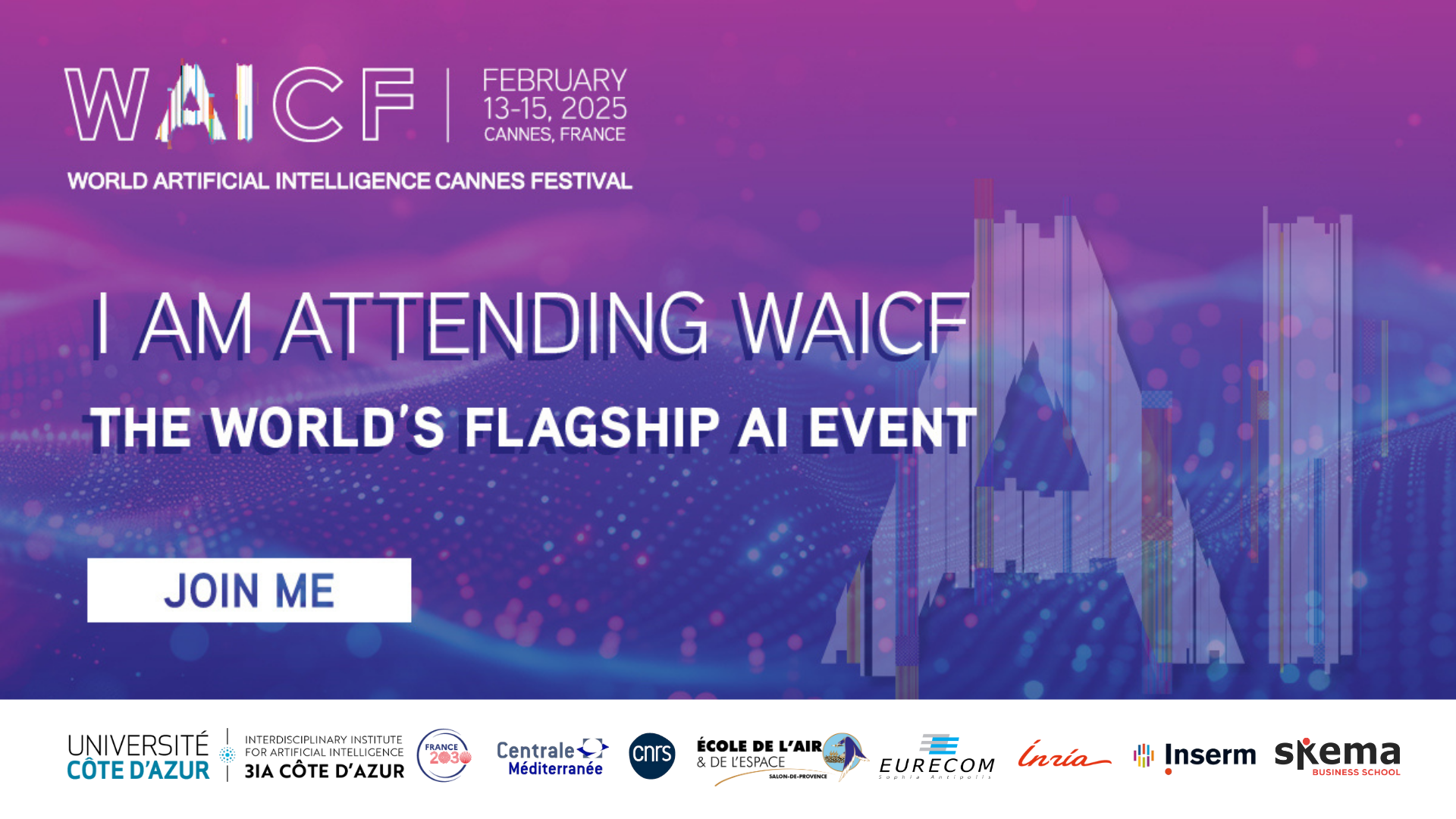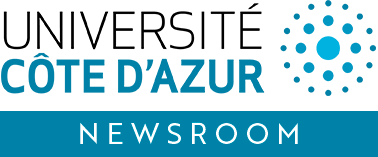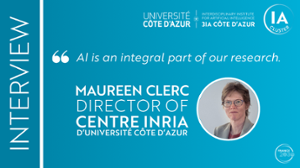from February 13, 2025 to February 15, 2025

The 3IA Côte d'Azur team and its members look forward to seeing you at WAICF 2025!
The World AI Cannes Festival brings together the people and companies that are currently building the most game-changing and purposeful AI strategies on the planet.
3IA Côte d'Azur will be present for the third consecutive year at the WAICF, with members from Université Côte d'Azur, Inserm, CNRS, Inria, Skema, Ecole de l'Air et de l'Espace, and Eurecom.
On this occasion, the Interdisciplinary Institutes of Artificial Intelligence (3IA), now recognized as 'IA-cluster,' are convening at the WAICF: 3IA Côte d’Azur / ANITI / MIAI-cluster / PRAIRIE
Come and discover start-ups emerging from academic research, learn about AI training programs (EFELIA), and engage in discussions about high-level AI scientific projects with top-tier researchers.
The CNRS and INRIA teams, dedicated to fostering partnerships, technology transfer, and innovation, are eager to discuss potential collaboration opportunities with you.
Meet us on our stand in K10!
Partnerships & innovation
Access to a world-class AI scientific expertise and engineering through R&D collaboration partnerships. We offer various collaboration schemes to accelerate your R&D and innovation project based on AI.
Contact our partnership teamSubmit a partnership proposal
PROGRAM
Thursday February 13
- Innovation
-
OneTreck®: Cyril Wyon-Boyault, CEO - Ph.D., and Mathilde Proponnet-Guerault, COO - Ph.D. (MIAI Cluster IA)
▸ From 9:00 am – 10:30 am
Medical deserts, Digital twins, Embedded technology, AI for healthcare, Dual applications, resilience
OneTreck® develops medical oases for isolated environments, providing diagnostic and prescription support for medical personnel (rural areas, war zones, natural disasters, space exploration).
FairVision: Jean-Michel FELDERHOFF, CEO, and Billel MIDOUNI, Computer Vision / Deep Learning Engineer (3IA Côte d’Azur)
"Live the game, Master the play with Argos"
Abstract: Inspired by the Greek god "ARGOS Panoptes", renowned for his unrivalled vigilance with a hundred eyes, this revolutionary system takes sports analysis into a new era.
▸ From 10:30 am to 2:00 pm
SPLEAT: Edgar Lemaire (PhD) Co-founder & CEO @ AICO Technology (3IA Côte d’Azur)
"Ultra-low-power bio-mimetic AI system applied to gesture recognition"
Abstract: This is a demonstration of gesture recognition using artificial intelligence, carried out with an entirely neuromorphic tool chain (i.e. inspired by the functioning of the biological brain), from sensor to processor. An event-driven camera (also known as an artificial retina) films the user and transmits the data to our SPLEAT neuromorphic processor, which emulates a bio-inspired neural network (SNN) to determine the user's gesture from 11 pre-defined possibilities. The use of end-to-end neuromorphic technologies enables unprecedented energy savings for the entire system, which consumes around 100 mW in total, compared with around 5 W for a conventional system - a reduction by a factor of 50. These same savings can be applied to more concrete use cases, such as voice transcription, autonomous navigation for drones, etc.
▸ From 2:00 pm to 4:00 pm
Facila: Valeriya STRIZHKOVA, Research Scientist | Computer Vision and Deep Learning (3IA Côte d’Azur)
We will present two interactive demonstrations showcasing how AI can enhance voice
1. "Facile à prononcer": Easier pronunciation starts here. Users select a French phrase and pronounce it while the app analyzes their speech. It detects mispronounced phonemes and incorrect muscle use, providing real-time feedback with precise corrections.
2. "Facile à chanter": Easier vocal control begins with this demo. Users engage in a vocal warm-up exercise while the app evaluates pitch accuracy and suggests muscle adjustments, helping them articulate more clearly and refine their singing technique.
▸ From 4:30 pm to 6:00 pmInn’Pulse: Rafael DA SILVA and Pierre-Henri CADET (3IA Côte d’Azur)
Miniaturized cardiac defibrillator
Survival from sudden cardio-respiratory death depends on cardiac massage and the emergency application of a defibrillator. Every minute without intervention means a 10% chance of recovering vital cardiac functions. The systems available are often fixed, weighing around 2 kg and sometimes inoperable due to lack of maintenance. We are proposing a miniaturized device weighing just a few hundred grams, available to everyone, combined with a Smart Phone.▸ From 1:00 pm to 4:00 pm
LiteSens: Jonathan Baudot, Project sponsor (MIAI Cluster IA)
Frugal AI, ambient computer vision, very low power consumption
LiteSense aims to democratize frugal ambient AI, i.e. intelligent applications that interact with the physical world continuously (via image sensors) and with very low power consumption.
We are looking for industrial partners to bring value in autonomous applications (no need for any connection) running on batteries or solar panels.
▸ From 4:00 pm to 6:00 pm - Research
- 3IA Techpool (3IA Côte d’Azur)
Demos
Find all details below
▸ From 9:00 am to 10:30 am
Giovanni GATTI PINHEIRO, research engineer (3IA Côte d’Azur)
"EURECOM’s Socratic LLM: Meet 'EULER'"
EULER (EUrecom Language model for Education and Research) is an AI-based tutor for students, a companion that students can interact with to better learn, in a personalized way, technical knowledge about the graduate courses EURECOM is teaching. EULER enables to manage course materials (video lectures, textbooks, lecture notes, slides, etc.) that are fed in a RAG architecture. EULER also provides fine-tuned models to simulate a Socratic behavior.
▸ From 9:30 am to 10:30 am
Maria Zuluaga, Chairholder, and Vincenzo Marciano, Ph.D. (3IA Côte d’Azur)
"Can we trust AI when it comes to healthcare?"
Abstract: The increasing reliance on AI in medical imaging has introduced significant advancements in diagnostic accuracy and treatment planning. However, once deployed, the effectiveness of these AI-driven models must be continuously validated to ensure their reliability in clinical settings. This raises the question: Can we trust AI in medical imaging? The need for rigorous quality control (QC) models is imperative to assess the performance of nowadays segmentation algorithms. These QC models must be capable of evaluating the accuracy and consistency of AI-generated segmentations, ensuring that they meet clinical standards.
▸ From 11:00 am to 1:00 pm
Nicolas CHAHINE, AI research scientist (PR[AI]RIE)
"Boosting image quality with the best of modern deep learning and optimization approaches"
Abstract: Where modern machine learning meets physical models of image formation and optimization methods for inverse problems: Enhance Lab exploits the latest research results in computer vision, machine learning and optimization from world-renown scientists at ENS-PSL and Inria. Its software performs joint demosaicing, denoising, super-resolution and HDR imaging from raw image bursts, with unmatched performance on real bursts acquired by hand-held devices such as smartphone cameras.
▸From 12:00 pm to 1:00 pm
▸From 4:00 pm to 5:00 pm
Seongro YOON, Ph.D. (3IA Côte d’Azur)
"Comprehensive Emotion Understanding and Applications"
Abstract: Recently, understanding human emotions has been highly anticipated for its utility, ranging from psychological or cognitive understanding to various marketing analyses. In the field of artificial intelligence, as a huge knowledge model utilizing language and images of massive data has been successfully developed, research on understanding highly complex human psychology has finally begun actively. In this study, we aim to increase the machine's understanding of human emotional states by obtaining various physiological signals from humans and utilizing various forms of modeled huge knowledge corresponding to them.
▸ From 9:00 am to 1:30 pm
Tomasz STANCZYK, Ph.D. (3IA Côte d’Azur)
"Temporally Propagated Masks and Bounding Boxes: Combining the Best of Both Worlds for Multi-Object Tracking"
Abstract: Multi-object tracking (MOT) involves identifying and consistently tracking objects across video sequences. Traditional tracking-by-detection methods, while effective, often require extensive tuning and lack generalizability. On the other hand, segmentation mask-based methods are more generic but struggle with tracking management, making them unsuitable for MOT. We propose a novel approach, McByte, which incorporates a temporally propagated segmentation mask as a strong association cue within a tracking-by-detection framework. By combining bounding box and propagated mask information, McByte enhances robustness and generalizability without per-sequence tuning. Evaluated on four benchmark datasets - DanceTrack, MOT17, SoccerNet-tracking 2022, and KITTI-tracking - McByte demonstrates performance gain in all cases examined. At the same time, it outperforms existing mask-based methods.
▸ From 9:00 am to 1:30 pm
Deborah DORE, Ph.D. (3IA Côte d’Azur)
"Argument Mining in Political Debates"
Abstract: Argument Mining deals with analyzing argumentation in various domains.
The ability of identifying argumentative components and predicting their relations opens the door to cutting-edge tasks like fallacy detection, fact-checking, and counter-argumentation generation. Argument mining is particularly useful in domains such as political debates where discovering hidden strategies behind someone' speech can help the public identify fallacies and manipulations. This will ultimately help voters make more informed and thoughtful decisions.
▸ From 1:30 pm to 5:00 pm - Education & Training
-
EFELIA-MIAI IA Cluster
▸ From 9:00 am to 1:30 am
École de l’air et de l’espace
▸ From 9:00 am to 5:00 pm
EFELIA Côte d’Azur
▸ From 9:00 am to 5:00 pm - Partnerships
-
STIP Inria (Inria innovation transfer and partnership department)
▸All day
Inria Startup Studio
▸All day
SPV CNRS (CNRS partnership and development department)
▸ From 9:00 am to 3:30 pm
Terra Numerica
▸All day
- Innovation
-
OneTreck®: Cyril Wyon-Boyault, CEO - Ph.D., and Mathilde Proponnet-Guerault, COO - Ph.D. (MIAI Cluster IA)
Medical deserts, Digital twins, Embedded technology, AI for healthcare, Dual applications, resilience
OneTreck® develops medical oases for isolated environments, providing diagnostic and prescription support for medical personnel (rural areas, war zones, natural disasters, space exploration).
▸ From 8:30 am to 9:00 am
▸ From 12:30 pm to 13:30 pm
EYENAV: Laurence COTTAZ, Ph.D. CNRS Transfer Engineer (3IA Côte d'Azur)
Homographic servo-control of underwater robots
Eyenav Robotics is a start-up working on drone-based underwater vision
▸ From 1:00 pm to 2:00 pm
SPOOQS: Guillaume TOUBLANC, Co-founder & CEO (MIAI Cluster IA)
Video AI, 1-click AI video effects, face blurring
Spooqs is a B2B solution for boosting videos in 30 seconds with AI by adding visual effects
▸ From 2:00 pm to 3:30 pm
LiteSens: Jonathan Baudot, Project sponsor (MIAI Cluster IA)
Frugal AI, ambient computer vision, very low power consumption
LiteSense aims to democratize frugal ambient AI, i.e. intelligent applications that interact with the physical world continuously (via image sensors) and with very low power consumption.
We are looking for industrial partners to bring value in autonomous applications (no need for any connection) running on batteries or solar panels.
▸ From 8:30 am to 10:30 am - Research
-
3IA Techpool (3IA Côte d’Azur)
Demos
Find all details below
▸ From 9:00 am to 6:00 pm
Hélène TAP, Graduate School Director (ANITI)
"Training all employees in generative AI: a strategic development tool for companies"
Abstract: ANITI develops a generative AI training specifically for lifelong learning. Participants will learn to collaborate with these tools to automate repetitive tasks, generate innovative ideas and improve decision-making. The aim is to transform each employee into a key player in collective performance thanks to AI.
▸ From 9:00 am to 9:30 am
Marjorie ALLAIN-MOULET, Industrial Copilot / Gender diversity Committee Leader at ANITI & CS GROUP (ANITI)
"Women for AI: an important stake for ANITI"
Abstract: We'll be talking about why it's vital to attract more women to the AI professions, the think-tank we've set up at ANITI, the actions we've taken, our appeal to industrial partners and the links we've forged with female students.
▸ From 9:30 am to 10:00 am
▸ From 2:30 pm to 3:00 pm
▸ From 3:30 pm to 4:00 pm
Hélène TAP, Graduate School Director (ANITI)
"AI compliance Training"
Abstract: The university degree "AI Compliance" aims to help learners understand and master the regulatory framework applicable to artificial intelligence. While artificial intelligence is already widely used, the European legislator has established the first binding rules to follow when designing, marketing, and using AI systems (AI Act), in order to ensure AI is used in a way that respects fundamental rights and freedoms. The goal of the CIA training is to enable anyone interested in artificial intelligence to understand the obligations placed on those who wish to develop or use this tool, and how to best mitigate the legal risks arising from the development, marketing, or use of an AI system.
▸ From 2:00 pm to 2:30 pm
▸ From 3:00 pm to 3:30 pm
▸ From 4:00 pm to 4:30 pm
Bruno Sportisse, Inria CEO (3IA Côte d'Azur)
"Building the European Sovereign AI Cloud: the power of private-public partnerships"
Panel discussion with David Gurle (Founder HIVENET), Antoine Clerget (CTO HIVENET) and Olivier Beaumont (Research director, Inria)
▸ From 12:30 pm to 1:20 pm (Conference 3)
Jean-Pierre Merlet, Chairholder (3IA Côte d'Azur)
"NN-PES, a Neural Network Parametric Equations Solver"
Abstract: The purpose of NN-PES is to find possibly *all* solutions for a square system of equations whose coefficients are functions of a set of parameters P that belong to a bounded region R. NN-PES may find very quickly possibly all solutions for any instance of P in R. NN-PES mixes neural networks and deterministic methods and the solutions it provide are *exact *(i.e. they can be obtained with an arbitrary accuracy).
▸ From 10:30 am to 12:30 pm
Federica FACENTE, Ph.D. (3IA Côte d’Azur)
"AI for 3D-2D Registration of CT and Fluoroscopy: A Step Forward in TAVI"
Abstract: TAVI is a minimally invasive procedure for treating severe aortic valve stenosis, where accurate valve replacement is essential for optimal outcomes.
During the preoperative phase, a CT scan is acquired, and the procedure is planned. The intervention is fluoroscopy-guided, but poor soft tissue visibility complicates guidance and valve positioning.
To overcome this, we aim to generate augmented fluoroscopies through 3D-to-2D CT-fluoroscopy registration using a cascade CNN, combining coarse and fine stages for accurate, real-time alignment.
▸ From 12:30 pm to 4:30 pm
Ezem EKMEKCI, Ph.D. (3IA Côte d’Azur)
"Real-Time Surgical Assistant for Dissection Guidance"
Abstract: This research project focuses on developing an intelligent virtual assistant for surgeons using the DaVinci X robotic surgical platform. The work encompasses multiple aspects of surgical robotics, including tool detection and segmentation, as well as action recognition and detection. The ultimate goal is to enhance surgical procedures by creating an AI-powered assistant that can support surgeons during robotic operations. This research combines computer vision, machine learning, and surgical robotics to improve the safety and efficiency of robotic-assisted procedures.
▸ From 12:30 pm to 4:30 pm
Manasi KATTEL, Ph.D. (3IA Côte d’Azur)
"MRI-Ultrasound Image Registration for Prostate Cancer Care"
Abstract: 3D registration between magnetic resonance imaging (MRI) and transrectal ultrasound (TRUS) plays a crucial role in the management of prostate cancer, enabling precise targeting of the lesions during biopsy planning and radiotherapy. MRI provides superior resolution and better lesion visualization, while TRUS offers real-time guidance during interventions. Combining the complementary properties of these two imaging modalities with artificial intelligence solutions helps improve the accuracy of biopsy and radiotherapy procedures.
▸ From 10:30 am to 12:30 pm
Serena Villata, CNRS Research director, Deputy scientific director and Chairholder (3IA Côte d'Azur)
"Human-centered tech: fighting bias and amplifying inclusion (facilitated by Queens of Tech)"
Panel discussion with Caitling Kraft-Buchman (CEO / Founder WOMEN AT THE TABLE), Imane Dahou (Cybersecurity, Data Protection & Resilience services Manager SIA PARTNERS), Maeva Cecchi (Assistant secretary, WHAT06 + Lead UX and Diversity & Inclusion Ambassador AMADEUS)
▸ From 4:55 pm to 5:30 pm (Conference 2) - Education & Training
-
École de l’air et de l’espace
▸ From 8:30 am to 6:30 pm
EFELIA Côte d’Azur
▸ From 9:00 am to 5:00 pm - Partnerships
-
STIP Inria (Inria innovation transfer and partnership department)
▸ All day
Inria Startup Studio
▸ All day
SPV CNRS (CNRS partnership and development department)
▸ From 9:00 am to 3:30 pm
Terra Numerica
▸All day
3IA Techpools demos
DeepWILDIn collaboration with Charles Bouveyron's chair (Equipe MAASAI - INRIA), work on DeepWILD has led to the development of a method for identifying, monitoring and counting animal species present in the Mercantour National Park. The demonstrator enables the model to be tested on animal photos collected using photo traps set up in the park.
Digital & Sustainability
Questionnaire about the environmental impact of AI and the digital sector in general. In collaboration with Marina Teller's chair (Law & AI, DL4T team, Université Côte d'Azur).
DISPUTool
Developed in collaboration with Elena Cabrio's chair of the INRIA-I3S WIMMICS team, DISPUTool is a tool for exploring, detecting and analyzing the argumentative components and strategies used in political debates. In particular, DISPUTool proposes to explore the transcripts of televised debates associated with American presidential elections since 1960, the argumentative components present in the speeches, and the fallacious arguments used. An interface also lets you test the model on customized text extracts.
Fed-BioMed
Fed-BioMed open-source framework developed at INRIA by Marco Lorenzi's EPIONE team, enabling hospitals and other medical research players to use the federated learning paradigm to train machine learning models on healthcare data subject to strict confidentiality constraints. Federated learning also offers other advantages in terms of security, computational resource requirements and so on.
Indago
Indago implements a text graph clustering approach based on a joint analysis of the graph structure and the content exchanged between nodes, resulting in a more precise segmentation than could be achieved with traditional approaches. The interest in using this technology lies in the analysis, exploration and synthesis of massive communication networks such as Twitter. Indago is based on the work of Charles Bouveyron (MAASAI Team, INRIA) and Pierre Latouche (LMBP, Université Clermont-Auvergne / DepMap, École Polytechnique).
Inn'Pulse
This demonstrator shows the technology integrated into the pocket defibrillator created by start-up Inn'Pulse, in collaboration with Maxime Sermesant's team (EPIONE, Inria). The innovative nature of this device lies in the use of AI models to automatically determine whether the cardiac defibrillator should send an electric shock.
Learn3D
In the context of machine learning applied to content generation, Pierre Alliez's TITANE team (INRIA), in collaboration with researchers at LIX Polytechnique, have developed a method for generating meshes, which are discrete representations of 3D objects. The aim is to bridge the gap between geometric processing and machine learning, to ensure that learning models are compatible with applications that manipulate 3D objects.
MEL
MEL (Modeling and Estimating Learning) is a project that aims to understand how people learn. The demonstrator takes the form of an object classification game in which the player answers a succession of tests, and AI techniques are used to determine the learning model closest to the one used by the player to produce his or her answers. This demonstrator is based on the work of Patricia Reynaud-Bouret's team (CNRS, LJAD, Université Côte d'Azur).
NN-PES
In many scientific fields, it's common to have to solve systems of parametric equations. This project, led by Jean-Pierre Merlet (HEPHAISTOS, INRIA), aims to solve, using neural networks and deterministic methods, any system of non-differential parametric equations, while minimizing the probability of not finding all the solutions.
PEACE
With the growing presence of hate speech on social networks, the need for content moderation tools is becoming a real issue. While most research to date has focused on developing automatic methods for detecting explicit hate speech, the PEACE (Providing Explanation and Analysis for Combating Hate Expression) framework produced by Serena Villata's team (WIMMICS, INRIA-I3S) aims to detect more subtle or implicit forms of hate speech, and then explain the results of these predictions using natural language.
QUALIA
QUALIA is a project of the LEAT laboratory (Benoît Miramond's Chair) to enable the integration of AI into ultra-low-power embedded devices. The project is illustrated here by a problem of detecting risky behavior in the elderly, in particular reduced mobility and the risk of falling, using connected glasses.
ReID
The result of work by INRIA's STARS team and François Bremond's chair, ReID aims to explain the issues involved in a fundamental problem in computer vision: re-identification - the ability to correctly identify an entity (an object, a person) from several viewpoints, in the presence or absence of obstacles, etc.
The demonstrator is presented in the form of a game, and compares the performance of supervised and unsupervised approaches.
Smarthome
The aim of this demonstrator is to present the Toyota Smarthome dataset, used in a context of automatic activity recognition based on video. Associate researcher: François Bremond (STARS team, INRIA).
Syndemie
As part of a study designed to investigate environmental, social and economic factors on the health of citizens, and in collaboration with the Nice Côte d'Azur Metropolis, the Nice IHU and Gredeg, we have carried out a statistical study on geographical disparities in the Alpes-Maritimes concerning breast cancer screening among women aged 50 to 74 between 2019 and 2021.
Trichtrack
Trichtrack is a demonstration of an algorithm for tracking individuals in a video, applied to videos of very small insects: trichogramma (micro-gups less than 1mm long, used in agriculture as an alternative to chemical pesticides). To study trichogramma, researchers at the INRAE institute need tools that enable them to measure several behavioral traits in a large number of individuals: their movements, their activity, their interactions, and so on. Project carried out with François Bremond's chair (STARS team, INRIA).
Webcrow 2.0
Developed by Expert.AI and the University of Siena, WebCrow is the first software package based on NLP techniques to automatically solve crossword puzzles. Initially developed for Italian and English, the 3IA TechPool has contributed to integrating the model in French. Marco GORI Chair - MAASAI, INRIA.




